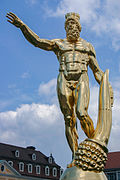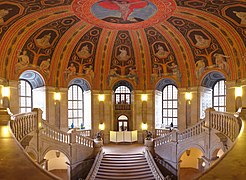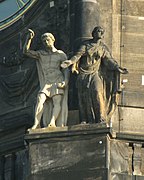New Town Hall (Dresden)

The New Town Hall in Dresden is the seat of the Dresden city administration. It is located southeast of the Altmarkt on Dr.-Külz-Ring.
history
As early as 1870/1875 , the Old Town Hall , located on the Altmarkt, no longer offered enough space for the city administration, so that shortly after taking office in 1880, the then Lord Mayor Paul Alfred Stübel discussed a new building. However, it was not until 1888 that a corresponding council decision was passed. It was not until 1901 that an architectural competition for a new town hall was announced. Under the title In the competition for the new town hall in Dresden award-winning and purchased drafts together with the official draft of the municipal building construction office / property of the city of Dresden / intended for the brothers of the municipal colleges , the collotype company by Römmler & Jonas produced a two-part portfolio . The architect Karl Roth (1875-1932) from Darmstadt received one of the four prizes for his contribution (a 1st prize was not awarded) and on the basis of his design the new town hall was built from 1905 to 1910 under the joint construction management of the architects Karl Roth and Edmund Bräter (1855–1925), for whom, among other things, the classicist Preussian House and the Palais Loß from 1765 were demolished. The foundation stone for the New Town Hall was laid on September 29, 1905, including the last King of Saxony, Friedrich August III. did three hammer blows. In 1908 the shell construction with the sandstone facade and the high pitched roofs was completed, whereby there were considerable financing problems. B. the town hall tower can only be built with generous support from the Güntz Foundation . For the next two years, work was carried out on the ornate interior, and the ballrooms were painted by Eugen Bracht . The inauguration took place on October 1st, 1910.
The building was badly damaged in the bombing raids in February 1945 , so that the extensive reconstruction was carried out in a simplified form from 1948 under the direction of Emil Leibold. There was no reconstruction of the decoration in the ballroom. In 1952 the complex on Dr.-Külz-Ring was completed, 1962–1965 the rebuilding of the ballroom wing followed by Herbert Terpitz , Manfred Arlt and collective (interior design: Theo Wagenführ). The interior design of the new plenary hall was the responsibility of the Hellerau workshops . From 2011 to 2016 this wing was extensively renovated and the staircase and the golden gate largely restored to their original state.
The larger-than-life sculpture " Trümmerfrau ", created in 1952 by Walter Reinhold , stands on the Rathausplatz east of the town hall and is intended to commemorate the many women who removed the mountains of brick rubble in the destroyed city after 1945. In 1967 the original cast iron was cast in bronze.
Rubble Woman monument in front of the town hall
Staircase design by Otto Gussmann (1910–1914)
Golden gate with the two lions by Georg Wrba
Town hall tower
The town hall tower is 100.30 meters high (with figure, including lightning rod), a public viewing platform is 68 meters high. The town hall clock has a diameter of four meters. The golden town hall man on the tower has a height of 5.05 meters from the base to the crown.
From spring to autumn of each year, the viewing platform and the tower station on the 7th floor and the tower cabinet on the 11th floor invited Dresden residents and guests of the city. From the viewing platform at a height of 68 meters there was a view of the whole of Dresden, the river landscape of the Elbe and, if the visibility was good, as far as Saxon Switzerland . For safety reasons (fire protection), the platform has been closed to the public since 2015, a reopening is currently unknown.
At the height of the viewing platform there are 16 larger-than-life sandstone figures. The partially restored statues represent 16 virtues (starting counterclockwise in the north): love, hope, mercy, piety, faith, faithfulness, courage, perseverance, strength, sacrifice, wisdom, goodness, justice, truth, vigilance and prudence. The statue of kindness, which can be seen in the foreground on the post-war photo, view from the town hall tower to the south by Richard Peter , gained particular fame . Bruno Fischer made sacrifice, strength, truth and justice , Peter Poeppelmann love, hope, prudence and vigilance , August Schreitmüller wisdom, courage, loyalty, perseverance, faith and goodness and Arthur Selbmann piety and charity .
See also
Web links
- The New Town Hall - The history on dresden.de , accessed on February 12, 2014 ( PDF ; 478 kB)
Individual evidence
- ↑ a b Landeshauptstadt Dresden (Ed.): The New Town Hall - The Prehistory. 4th updated edition, July 2010, accessed on February 12, 2014 (PDF; 478 kB).
- ^ A competition design for the new town hall in Dresden by the Berlin architect Heinrich Schweitzer in the architecture museum of the TU Berlin
- ^ In the catalog of prints by Römmler & Jonas of the German National Library
- ↑ Katrin Richter: Dresden City Hall: "Golden Gate" opens on April 2nd. Dresden Latest News from March 17th, 2016, online , accessed on March 30th, 2020.
- ↑ The town hall tower , accessed on June 17, 2020
Coordinates: 51 ° 2 ′ 53 ″ N , 13 ° 44 ′ 28 ″ E













